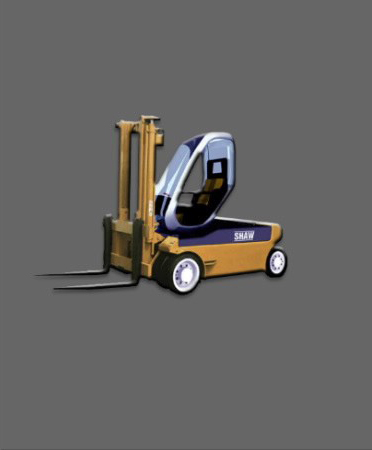 Shaw Handling will launch its "revolutionary" iLift forklift range this year. |
Abu Dhabi-based Shaw Handling wants to compete with Kalmar, Hyster and Linde in the medium to heavy forklift market and will launch a "revolutionary" forklift range in the second or third quarter of this year.
The new company's forklift range consists of lift capacities from 5,000-18,000kg (11,023lb-39,683lb) and has Daimler-Chrysler engines and transmissions from Poclain Hydraulics.
Shaw claims the engine-powered counterbalanced forklifts "completely overturn conventional design parameters with its novel concept to provide productivity, comfort and economy".
David O'Callaghan, Shaw's chairman and founder, says competitors' basic designs have not changed since Clark first designed a forklift in 1917.
"The basic design is a mast, chassis with paneled oil and fuel tanks and ballast weight. The chassis and paneled tanks have one fault - they hamper the access to the engine and transmission components. As the engine is in a high position, the centre of gravity is higher and more ballast is needed for stability."
Shaw's iLift forklifts are different because they are designed using modular construction and have less ballast and a lower centre of gravity. The forklifts also have a hydrostatic transmission instead of a torque converter. Linde is currently the only manufacturer producing forklifts of 10,000kg (22,046lb) and over with hydrostatic transmission.
The iLift range has a kit-form design incorporating seven units - low centre of gravity ballast weight, clear view duplex mast, driver's cab, a power pack, rear axle, front wheel motors and a chassis.
According to O'Callaghan, the ballast weight and chassis require no maintenance or replacement. If any of the other five units is faulty, it can be temporarily replaced while the faulty unit is brought to the factory for repairs. He explains that the hydrostatic design enables a rapid and easy changeover of units, not offered by conventional manufacturers.
"Unlike conventional transmissions, the Shaw hydrostatic drive has no multiple clutch pack, no mechanical differentia, no reverse gears, no gear selection lever and none of the wear and maintenance associated with these components, and is virtually maintenance-free," O'Callaghan claims.
The company plans to be a top five heavy materials handling equipment manufacturer in Europe, Africa and the Middle East, selling 352 units per year, in five years' timeIt will also expand its range by adding 20,000-32,000kg (44,092-70,548lb) capacity forklifts and an empty and laden container handling forklift range. All products will be based on the modular construction platform and have hydrostatic transmission.
Shaw has a manufacturing base at Abu Dhabi's 12 sqkm (2,965 acre) 1CAD111 industrial zone and a research and development centre in the UK.
"As heavy materials handling in the Middle East continues to expand, Abu Dhabi will emerge as a worldwide heavy materials handling hub with one of the world's largest ports nearby in Dubai." O'Callaghan says. Shaw can ship units globally via Taweelah Port and Jabel Ali Port in Dubai.
Shaw is currently building a new 40,000 sqm (430,556 sqft) plant and a 20,000 sqm (215,278 sqft) training academy in Abu Dhabi that will be completed at the end of 2009.
By 2020, Shaw aims to employ over 450 people and sell over 2,000 units. Its 40,000sqm (430,556sqft) factory is also expected to double in size then.
O'Callaghan says: "The main aim of the company is to become the world's largest heavy forklift manufacturer by 2020."
To succeed, O'Callaghan aims to position Shaw as a leader in the market for its technology, innovation and comprehensive service; commit to operational excellence;, be highly profitable; follow a clear strategy with long-term growth benefits; and attract, develop and retain talented employees.
O'Callaghan adds that Shaw is talking to a top 20 forklift manufacturer on a possible joint venture but cannot comment further.
UK-born David O'Callaghan, 44, started in the asset rental side of the forklift industry in 1996 when his employer invested in a forklift deal. He wanted to start Shaw in late 2005 but family commitments became an obstacle.
"I have always kept an eye on the industry through my involvement in asset rentals so I was up to speed on the market and could see this opportunity," he says.